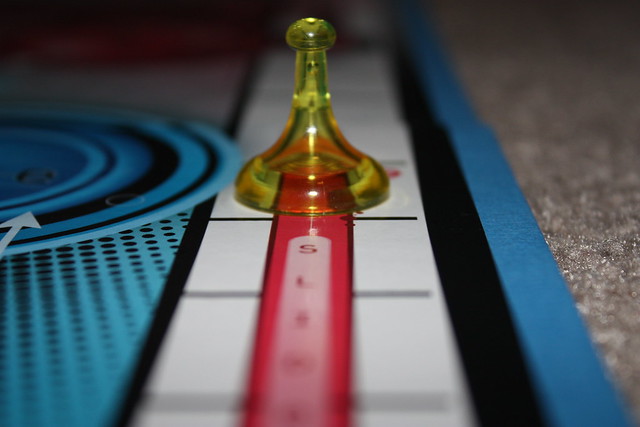
The "roll-and-move" category of games often gets bad rap. Sure, they're often the first games we learn as kids. And for a long time, there was a glut of games that used the mechanic any further thought to the design.
Perhaps there's also just a strain of bitterness because that's the extent of what the vast majority of people imagine a board game being: Simply rolling, moving, and following instructions wherever you landed.
Whatever the reasons, I think the stigma is unfair. The mechanic is just a neutral tool, either used well or used poorly, but has its strengths and weaknesses inherent in itself. Listening to this episode of Ludology got me thinking about ways to add just a little spice to some mass-market roll-and-move games like Monopoly and Life.
- First, you'll need one die for each player.
- Determine initial turn order randomly.
- Before anyone takes a turn, roll all the dice.
- The first player takes one result out of the pool and moves that many spaces on the board. Continue with the remaining players.
- If players can occupy the same space, keep the latest entering player closer to the interior of the board.
- From then on, between rounds, roll all the dice. The player who is farthest behind takes their choice of result first, followed by the second-to-last player, and so on until the player in first gets last choice.
- If tied in position, the player furthest to the outside gets first pick.
Now you could easily take this kernel and start making a more interesting roll-and-move game all on its own. For example, imagine the game was about racing vacuum robots trying to suck up valuable goodies from the floor while avoiding tacks, spills, and other hazards.
- Each time you land on a "penny" space, collect a penny token. You can spend three pennies at any time to double your move.
- Each time you land on a "tack" space, collect a tack token. You can spend three tacks to get first choice during the dice selection.
- Each time you land on a "spill" space, collect a spill token. You can spend three spills to move to an unoccupied space behind the leader.
And so on, add as many different little items as you like. The key thing is to give players a reason not to just take the highest result every time. Perhaps you want to add colored dice, to add yet another vector of decision-making? Perhaps you're trying to collect colors in a sequence or sets of colors as well? Here's an even wackier idea: Roll-and-Move Worker Placement
- The board features a track, oriented much like the Monopoly board. The key difference is that the spaces look like what you might normally see in a worker placement game, like Lords of Waterdeep.
- Right in front of the starting space, you'll find, say, 5 spaces that are very modest, giving you one ore, one wood, draw one card, etc.
- The further you go beyond the starting space, the more exotic goods you can acquire or actions you can take.
- The closer you get to making a full circuit around the board, the more straight victory points you might acquire.
Here is the key rule that I think would make this actually work as a tense, strategic game. On your turn, you may
- Take a die result and move your pawn that many spaces, OR
- Move your pawn back to one five earliest spaces.
- Either way, you execute the action of the space on which you land.
So the tension is whether to go back to the modest, but predictable earliest parts of the track. The cost of doing so is losing any progress you've made on towards those lucrative upper echelons. By contrast, there is also a cost in pursuing those lofty reaches, as your acquisitions may be less predictable and the progress quite slow if you stay in the lead.
No comments:
Post a Comment